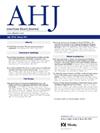Understanding gaps in guideline-recommended adult congenital heart disease care: Data from 12 US health care centers
IF 3.5
2区 医学
Q1 CARDIAC & CARDIOVASCULAR SYSTEMS
引用次数: 0
Abstract
Background
Guidelines recommend lifelong care with adult congenital heart disease (ACHD) specialists for adults with congenital heart disease (CHD). However, such gaps in visits at specialized ACHD centers have not been well-characterized from diverse US settings.
Methods
This retrospective study analyzed data from 12 centers in the national Patient-Centered Clinical Research Network. CHD conditions were classified using International Classification of Disease codes and a hierarchical algorithm. ACHD specialists were identified by investigators and encounter volumes. Data from the ‘Pre-COVID’ (2015-2019) and ‘COVID’ (2020-2022) periods were analyzed separately. Main outcome measures were: 1) Gaps in any ACHD specialist visit and recommended testing throughout the study period. 2) Gaps in recommended ACHD follow-up care.
Results
During pre-COVID (N = 18,934) and COVID (N = 22,453) periods, between 55.3%-55.8% were males, 27.2%-31.0% were 40+ years, 18.2%-19.6% had severe CHD, and 52.7%-55.0% had CHD physiologic class B-D conditions. Between 47.0%-54.5% had gaps in specialist visit and 13.0%-24.6% had gaps in all the testing. Patients with gaps in specialist visits were 6.33-9.44 times more likely to have gaps in testing. Gaps were more common among patients with moderate (adjusted odds ratio [AOR]: 2.61) and simple (AOR: 2.84) CHD, those aged 40+ (AOR: 1.53) and nonphysiologic class conditions (AOR 1.51). In both periods, 64.1%-71.5% of patients had gaps in follow-up care.
Conclusions
Three-quarters of adults with CHD experienced gaps in specialized ACHD care while receiving services at high volume comprehensive tertiary health centers. To address these gaps, interventions such as fostering physician collaboration within tertiary centers might be needed, and targeted to patients with less severe CHD, nonphysiologic class conditions, and those aged 40+ years.
了解指南推荐的成人先天性心脏病护理的差距:来自12个美国卫生保健中心的数据
背景:指南推荐成人先天性心脏病(ACHD)专家对成人先天性心脏病(CHD)进行终身护理。然而,这种在专门的ACHD中心就诊的差距并没有从不同的美国环境中得到很好的表征。方法:本回顾性研究分析了来自国家以患者为中心的临床研究网络的12个中心的数据。使用国际疾病分类代码和分层算法对冠心病进行分类。ACHD专家由调查人员和接触量确定。分别分析了“Pre-COVID”(2015-2019)和“COVID”(2020-2022)期间的数据。主要结果测量是:1)在整个研究期间,任何ACHD专家访问和推荐测试的空白。2)推荐的ACHD随访护理存在差距。结果:在COVID前期(N=18,934)和COVID期间(N=22,453),男性占55.3% ~ 55.8%,40岁以上占27.2% ~ 31.0%,重度冠心病占18.2% ~ 19.6%,冠心病生理B-D级占52.7 ~ 55.0%。47.0%-54.5%的人在专家访问方面有差距,13.0%-24.6%的人在所有测试方面都有差距。在专家访问中有空白的患者在测试中有空白的可能性是6.33-9.44倍。差距在中度(调整优势比[AOR]: 2.61)和单纯性(AOR: 2.84)冠心病、40岁以上(AOR: 1.53)和非生理性类疾病(AOR: 1.51)患者中更为常见。在这两个时期,64.1%-71.5%的患者在随访护理方面存在空白。结论:四分之三的成年冠心病患者在接受高容量综合三级卫生中心服务时,在专门的ACHD护理方面存在差距。为了解决这些差距,可能需要采取干预措施,如促进三级中心的医生合作,并针对冠心病不太严重、非生理性疾病和40岁以上的患者。
本文章由计算机程序翻译,如有差异,请以英文原文为准。
求助全文
约1分钟内获得全文
求助全文
来源期刊

American heart journal
医学-心血管系统
CiteScore
8.20
自引率
2.10%
发文量
214
审稿时长
38 days
期刊介绍:
The American Heart Journal will consider for publication suitable articles on topics pertaining to the broad discipline of cardiovascular disease. Our goal is to provide the reader primary investigation, scholarly review, and opinion concerning the practice of cardiovascular medicine. We especially encourage submission of 3 types of reports that are not frequently seen in cardiovascular journals: negative clinical studies, reports on study designs, and studies involving the organization of medical care. The Journal does not accept individual case reports or original articles involving bench laboratory or animal research.
 求助内容:
求助内容: 应助结果提醒方式:
应助结果提醒方式:


